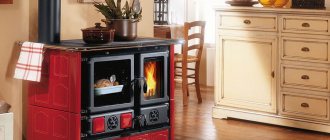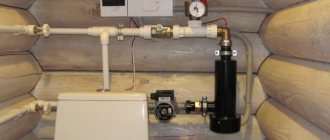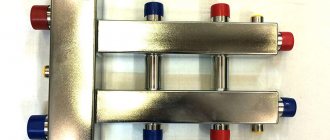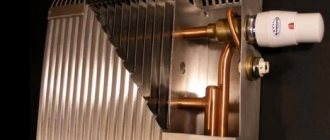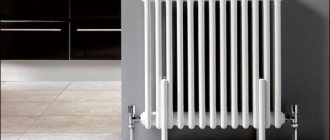Is it possible to economically heat a home with electricity? Many, without hesitation, will answer that no, remembering the most common heating device on heating elements - this is not true. Old military technologies, until recently inaccessible to ordinary citizens, are a reality.
Device for one and two phases We are talking about an ion boiler - an alternative heat source. Military technology developed back in the middle of the last century is now available to everyone.
History of appearance and principle of operation
It all started during the times of the USSR. The state, surrounded on all sides by potential military opponents, maintained a large navy. To provide life support for diesel submarines, enterprises of the USSR OK developed autonomous heating systems.
Such a submarine crew heating system had to meet such requirements as: simplicity, reliability, independence from exhaust, absence of moving parts and noise during operation, sufficient power in the harsh conditions of the Arctic Ocean, replaceable and accessible coolant.
The task was completed successfully and was used effectively until the collapse of the socialist state. In the 90s, the country's defense enterprises found themselves out of business. These are difficult times. To survive, consumers were presented with a civilian version of the electrode heater. Engineers D.N. Kunkov received a patent for this invention. and Ilyin A.P.
Difference from heating element
The principle of operation was elementary - the internal resistance of the coolant was used: instead of a metal heating element, salt water was used. Under the influence of electric current, the coolant molecules collide with each other and heat up, and the electrical energy is converted into thermal energy. For stable operation, an alternating current of 50-60 Hz (oscillation amplitude) is required, otherwise it starts to work like a battery.
Then a simple device was developed, with one electrode. A phase was connected to it, and a zero was connected to the metal body. The container contains coolant. For safety, the housing is grounded.
It turns out the following: a current with an amplitude of 50 Hz passes through salt water, which heats up in a short time; due to the temperature difference and the pressure created by the installation, the coolant circulates through a closed thermal system - it’s simple.
Characteristics: advantages and disadvantages
The design is simple and elementary, but has a number of unique properties:
- small installation dimensions, with significant equipment power;
- independently creates pressure in the system, which makes it possible to use it without injection pumps;
- completely anti-emergency system - overheating is not possible, operation stability does not depend on the coolant level;
- Convenience of temperature control - the automation will do everything itself: temperature sensors will work when needed;
- voltage drops in the power supply network do not affect the performance and safety of the system - it will produce less or more energy;
- the highest efficiency - the maximum of all existing heating devices;
- absence of radiation negative for life and health;
- easy to integrate into heating as an additional or backup source.
It might look like this.
To be objective, let's consider the disadvantages:
- operates only on alternating current, since direct current causes electrolysis;
- it is necessary to monitor the condition of the electrolyte (salt water) - distilled water is not acceptable, since it is a universal conductor, and requires a specific resistance for operation;
- in the absence of grounding, it is prohibited to operate the installation - it is dangerous to life;
- any resistance (resistor) decreases its nominal value as the temperature increases, and as a result, when heated to 75 ° C, the boiler significantly loses power, but the current increases;
- requires periodic cleaning of working elements, as losses begin to occur due to scale on the electrode(s);
- once every 2-3 years, replacement of the electrode(s) is required;
- with an extensive heating network, a pressure pump is required;
- insufficient water level in the heating system is critical, since water with salt impurities corrodes the metal;
- the complexity of physiological adjustment of water resistance - this is very difficult to do without a specialist;
- servicing the circuit requires special knowledge, skills, and special equipment.
Consumer Reviews
Ion boilers have both pros and cons. Positive user reviews point to the benefits discussed earlier. These are cost-effectiveness, ease of installation, safety, reliability, etc. Negative reviews from users using a flow-through ion heating boiler in the heating system indicate such disadvantages as the complexity of repair work and maintenance of the device, the need to use an additional pumping group of equipment, and the need for constant monitoring of electrical conductivity coolant, etc.
As you can see, reviews of electrode heating boilers are quite contradictory, so the consumer should carefully study the technical characteristics and operating features of a particular model before purchasing. The process of heating the coolant in ion boilers is fundamentally different from the operating principle of other types of electric heaters.
Through the use of innovative technologies, the developers managed to achieve impressive performance qualities of the ion boiler.
By integrating an ion heater into the circuit, the property owner can count on bonuses in the form of low heating bills and the ability to quickly and evenly heat the home.
Device and technical characteristics
The considered operating principle of an electric boiler gives a first idea of the design. Although this equipment is already about a hundred years old, the basic design has not changed. And externally, since the start of heating private residential buildings, it has remained the same. Only a few manufacturers have made minor changes to the layout of parts.
Characteristics of a single- and two-phase boiler
Externally, it is a cylinder measuring 30-50 mm in diameter with a thickening at the base in which the switching unit is located. A ½ or ¾ inch pipe is welded in slightly above it; a contour “return” is used to introduce coolant into the apparatus. The inlet pipe to the thermal circuit is soldered on top of the main cylinder, sometimes it is on the side, next to the “return”.
An electrode is located inside the cylindrical body, without contacting its walls. There is one if the device operates from a 220 V power supply, or three if it is an industrial design that requires a three-phase 380 V connection. These differences indicate different power. Efficiency depends on the amount of energy consumed. A device with a three-phase connection heats an area of about 1000 square meters.
The electrodes are fixed in the lower thickened part of the housing (switching unit), it is collapsible, with reliable electrical insulation from electric shocks. Usually it is polyamide.
Device diagram
The overall dimensions of the boiler, depending on the power, are slightly different, but are about 30 cm in length and 4 cm in width, weighing 15 kg, power varies from 2 to 50 kW. The energy consumption of single-phase does not exceed 6 kW, three-phase 50 kW. Operating temperature is 75 °C – at this temperature the device functions efficiently.
Each installation is additionally equipped with electromechanical control - these units differ both in size and function.
Electromechanical units are needed to control the electrode boiler. Thermal sensors are also installed: at the input and output of the circuit. They process the readings, calculate the temperature difference and control the power supply of the device (on, off). In addition to the basic options, expensive variations have more sophisticated functions, for example, determining hysteresis values, etc.
Simple DIY design
From the general description of the boiler it is clear that its mechanical component is elementary and not so complicated; more confusion is associated with the electromechanical control. But everything is in order.
To assemble this miracle device you will need tools and materials:
- a piece of pipe 1½-2 inches, 30-50 cm long;
- two small ½-inch pieces of pipe for the nozzles;
- copper wires with a cross-section of at least 3 mm²;
- electrode (steel rod) with a diameter of 1-1.5 cm;
- metal tee;
- coupling;
- welding machine, if the elements will be welded;
- tap and lever for cutting threads;
- rubber gaskets, fum tape.
From a pipe with your own hands
When starting work, repeat three simple requirements for the homemade system you are constructing:
- Phase to the electrode, zero to the body.
- It is prohibited to turn on the installation without grounding.
- Connect only through a machine (about 40 A), since the current increases as it heats up.
The boiler assembly procedure is as follows:
- a previously prepared section of pipe 30-50 cm long will serve as the body;
- the case should not contain defects, chips, the edges should be thoroughly cleaned;
- An electrode is placed on one edge of the housing, and a coupling for connecting to the thermal circuit is placed on the other.
To install the electrode rod, you need a steel tee; the return line is connected through it.
- The electrode is connected through a gasket, which insulates from electricity and seals the boiler body.
For the insulating layer, high quality plastic with heat-resistant properties is used.
- Two bolts are welded to the pipe-body using a welding machine to secure the ground and zero terminals.
One bolt can be welded. It will combine zero output and grounding.
- The finished ion boiler must be painted to preserve the metal from corrosion and to reduce the risk of electric shock.
After assembling and painting the boiler, you can begin to insert it into the system.
Installation features
To install an energy-saving boiler, it is necessary to install a safety valve, pressure gauge and automatic air vent. The horizontal position of the equipment is unacceptable; install it only vertically, without displacement.
The insertion into the thermal circuit is made so that the zero terminal is at the bottom. Wires connected to the boiler must have a cross-section of at least 4 mm². Connect only through machines, in accordance with all rules of the PUE.
For installation in a new main, only a used boiler is treated with inhibitors. Follow the recommendations for using cleaning products. Ignoring this point will lead to difficulties when setting the ohmic indicators of the liquid in the system.
For heating, the choice of radiators is important. Cast iron samples are not acceptable as they are prone to increased scale formation and other contaminants. It is better to select small radiator batteries, made of lightweight materials (aluminum), so that 1 kW of energy is consumed per 8 liters.
Parallel connection - power amplification
When choosing batteries, it is preferable to choose primary-type aluminum structures, since they contain significantly fewer impurities - this will reduce the overall resistance.
How to choose an ion boiler
The required power unit is selected from the condition that 1 kW of thermal power is sufficient to heat an area of 10 m2. You need to add approximately another 20% to the calculation to take into account the heat losses of the object.
In addition, before choosing, you need to clarify what function it will perform in the heat supply scheme, as the main source of heat or auxiliary to maintain the temperature at night or during periods of extremely low outside temperatures.
It will also be necessary to take into account the electrical load mode of 220V or 380V, and the possibility of an intra-house electrical network carrying the load through such a boiler. To select a specific model, you will need to take into account the heating scheme, so if the house has a “warm floor” system, the boiler power is selected 30% more.
Manufacturers and average cost
There is a wide variety of electric boilers on the market. Among them, heating devices manufactured by the following companies are popular:
- JSC "Galan" - Russia;
- LLC “Stafor_eko” – Latvia;
- LLC "EOU" - Ukraine.
Boilers and related equipment (electromechanics) for them are sold separately. The price of household products for 220 V electrical networks, with a power of 2 to 6 W, is determined by the amount of about 4-6 thousand rubles. Automation costs about the same - 6-7 thousand rubles.
When purchasing, pay attention to the warranty and service period. Usually it does not exceed 3 years, based on this, you can be sure that the boiler will last no less than this time. However, if you carry out maintenance of the equipment and change the electrodes and gaskets once every two years, you can increase the service life to 10-12 years.
Rating of the best coolants for heating systems
| Nomination | place | Name of product | rating |
| Rating of the best coolants | 1 | DIXIS-65 | 4.9 |
| 2 | Warm House Eco | 4.8 | |
| 3 | THERMAGENT-65 | 4.8 | |
| 4 | RODA | 4.7 | |
| 5 | AMT-300 | 4.7 | |
| 6 | Hot Stream | 4.7 | |
| 7 | Teplokom | 4.6 | |
| 8 | WARME BASIC-65 | 4.5 | |
| 9 | Thermagent Eco 30 | 4.5 | |
| 10 | FTX-30 | 4.5 | |
| 11 | PRIMOCLIMA ANTIFROST | 4.4 |


